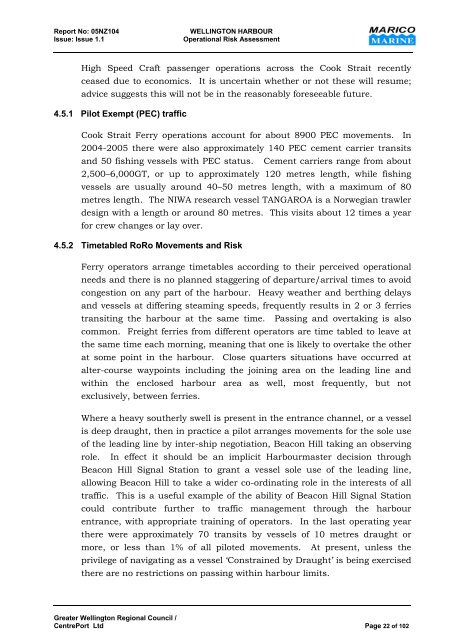MARICO Marine NZ Limited WELLINGTON HARBOUR PORT AND ...
MARICO Marine NZ Limited WELLINGTON HARBOUR PORT AND ...
MARICO Marine NZ Limited WELLINGTON HARBOUR PORT AND ...
Create successful ePaper yourself
Turn your PDF publications into a flip-book with our unique Google optimized e-Paper software.
Report No: 05<strong>NZ</strong>104 <strong>WELLINGTON</strong> <strong>HARBOUR</strong><br />
Issue: Issue 1.1 Operational Risk Assessment<br />
High Speed Craft passenger operations across the Cook Strait recently<br />
ceased due to economics. It is uncertain whether or not these will resume;<br />
advice suggests this will not be in the reasonably foreseeable future.<br />
4.5.1 Pilot Exempt (PEC) traffic<br />
Cook Strait Ferry operations account for about 8900 PEC movements. In<br />
2004-2005 there were also approximately 140 PEC cement carrier transits<br />
and 50 fishing vessels with PEC status. Cement carriers range from about<br />
2,500–6,000GT, or up to approximately 120 metres length, while fishing<br />
vessels are usually around 40–50 metres length, with a maximum of 80<br />
metres length. The NIWA research vessel TANGAROA is a Norwegian trawler<br />
design with a length or around 80 metres. This visits about 12 times a year<br />
for crew changes or lay over.<br />
4.5.2 Timetabled RoRo Movements and Risk<br />
Ferry operators arrange timetables according to their perceived operational<br />
needs and there is no planned staggering of departure/arrival times to avoid<br />
congestion on any part of the harbour. Heavy weather and berthing delays<br />
and vessels at differing steaming speeds, frequently results in 2 or 3 ferries<br />
transiting the harbour at the same time. Passing and overtaking is also<br />
common. Freight ferries from different operators are time tabled to leave at<br />
the same time each morning, meaning that one is likely to overtake the other<br />
at some point in the harbour. Close quarters situations have occurred at<br />
alter-course waypoints including the joining area on the leading line and<br />
within the enclosed harbour area as well, most frequently, but not<br />
exclusively, between ferries.<br />
Where a heavy southerly swell is present in the entrance channel, or a vessel<br />
is deep draught, then in practice a pilot arranges movements for the sole use<br />
of the leading line by inter-ship negotiation, Beacon Hill taking an observing<br />
role. In effect it should be an implicit Harbourmaster decision through<br />
Beacon Hill Signal Station to grant a vessel sole use of the leading line,<br />
allowing Beacon Hill to take a wider co-ordinating role in the interests of all<br />
traffic. This is a useful example of the ability of Beacon Hill Signal Station<br />
could contribute further to traffic management through the harbour<br />
entrance, with appropriate training of operators. In the last operating year<br />
there were approximately 70 transits by vessels of 10 metres draught or<br />
more, or less than 1% of all piloted movements. At present, unless the<br />
privilege of navigating as a vessel ‘Constrained by Draught’ is being exercised<br />
there are no restrictions on passing within harbour limits.<br />
Greater Wellington Regional Council /<br />
CentrePort Ltd Page 22 of 102
















